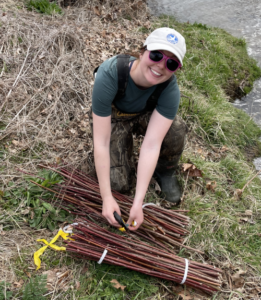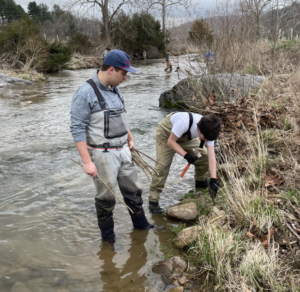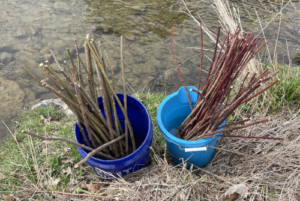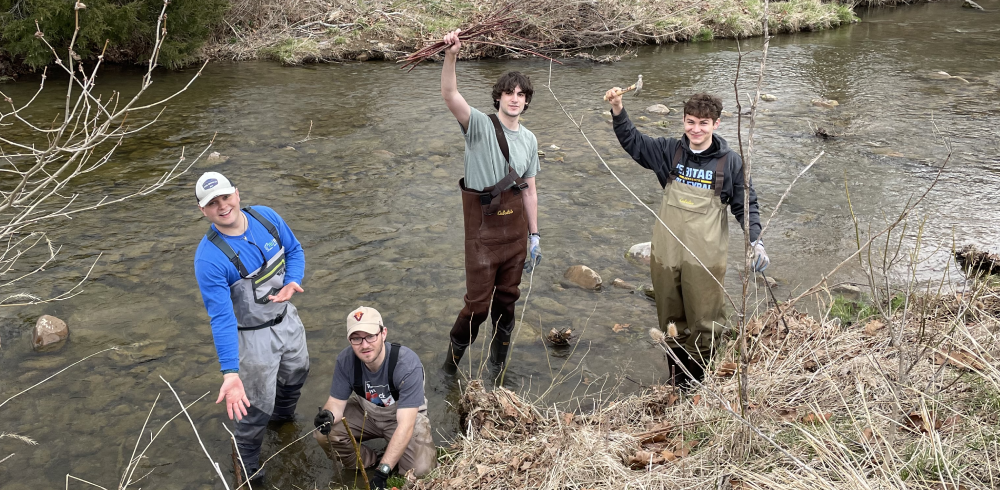The Magic of Live Staking: A Cheap and Easy Streambank Restoration Practice
 by Sarah Coffey, Chesapeake Bay Foundation
by Sarah Coffey, Chesapeake Bay Foundation
To survive the frequent disturbances along rivers and streams in the riparian zone, some woody plants have evolved to re-root when a small branch or twig falls onto the ground. This almost magical ability is called adventitious rooting.
We are able to mimic this natural process through a practice called live staking. Live stakes are dormant stem cuttings from live trees and shrubs that can be inserted directly into the streambank. They eventually grow into trees and shrubs whose roots stabilize the banks and protect water quality. Common Virginia native plants with this adaptation include black willow, pussy willow, red-osier dogwood, gray dogwood, silky dogwood, sycamore, elderberry, hazel/smooth alder, ninebark, and buttonbush.
Through the James River Buffer Program, Chesapeake Bay Foundation staff and volunteers planted 900 red-osier dogwood and black willow live stakes along eroded streambanks of three creeks in Rockbridge County this March. These sites were already planted with bareroot seedlings in fall 2021, but live stakes can only be planted during a certain window (ideally between late February and late March), before they begin to sprout.
 Installing live stakes requires that you stand in the creek. Depending on the depth of the creek, waders may be necessary. If the creek is shallow enough, knee-high boots may be sufficient to stay dry. Live stakes need to stay wet, so we planted them between one to two feet apart in the first row (just above the water line), and then staggered the second row about a foot above the first. It is best if they are perpendicular to the surface of the streambank, but most importantly, they should be inserted deep enough so that they won’t be dislodged during a heavy rain, flood, or other disturbance. A good rule of thumb is to have between half and three-fourths of the live stake below ground, leaving just enough room for some new buds to grow.
Installing live stakes requires that you stand in the creek. Depending on the depth of the creek, waders may be necessary. If the creek is shallow enough, knee-high boots may be sufficient to stay dry. Live stakes need to stay wet, so we planted them between one to two feet apart in the first row (just above the water line), and then staggered the second row about a foot above the first. It is best if they are perpendicular to the surface of the streambank, but most importantly, they should be inserted deep enough so that they won’t be dislodged during a heavy rain, flood, or other disturbance. A good rule of thumb is to have between half and three-fourths of the live stake below ground, leaving just enough room for some new buds to grow.
We found it easiest to first make pilot holes using rebar between 18 and 24 inches in length. We hammered rebar into the streambank using a mallet and then pushed the live stakes in the holes as deep as we could. When we hit rock—a common occurrence in Rockbridge County—we had to make a new pilot hole elsewhere that would be deep enough to hold the live stake in place.
While the practice of live staking is a great way to reforest any streambank, we prioritized areas most prone to erosion and lacking vegetation (usually the cut banks) to prevent further soil loss. The live stakes we planted may resprout during the first season, but what is most important is that they start growing a robust underground root network.
 Our volunteers—ranging from Washington & Lee University students to Master Gardeners with minimal to no experience—were surprised at how easy it was to plant live stakes, especially compared to bareroot seedlings. It’s not just easy to plant them, but it’s easy and cheap (or even free) to make your own!
Our volunteers—ranging from Washington & Lee University students to Master Gardeners with minimal to no experience—were surprised at how easy it was to plant live stakes, especially compared to bareroot seedlings. It’s not just easy to plant them, but it’s easy and cheap (or even free) to make your own!
Watch this video if you’re interested in learning how to cut your own live stakes using appropriate live staking sources on your property or someone else’s (with their permission, of course)! If you don’t have access to a live stake source already, there are several nurseries that can ship them to you: Mellow Marsh Farm, Foggy Mountain Farm, and Ernst Seeds are just a few.


